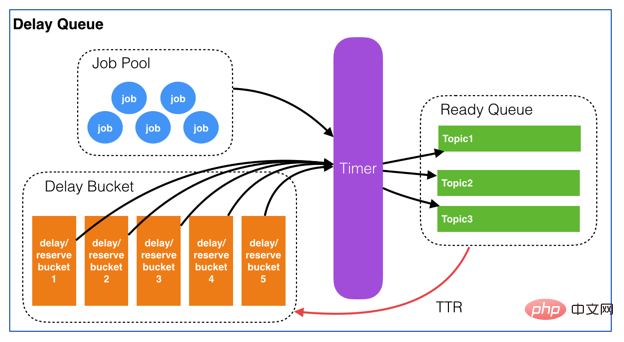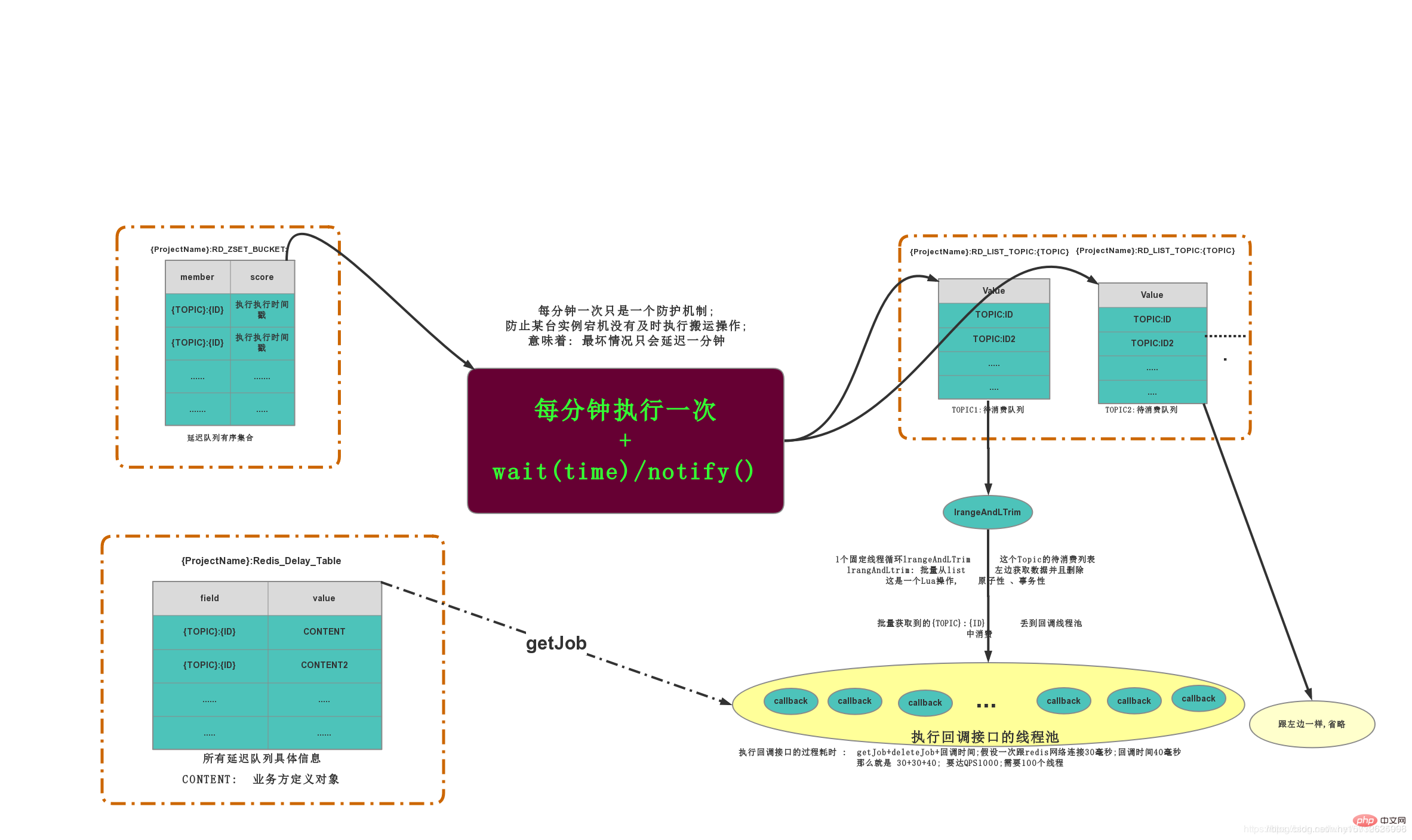
Delay queue, as the name suggests, is a message queue with delay function. So, under what circumstances do I need such a queue?
1. Background
Let’s first look at the following business scenario:
1.1 Solution
The simplest way is to scan the meter regularly . For example, if the order payment expiration requirements are relatively high, the meter will be scanned every 2 seconds to check expired orders and actively close the orders. The advantage is that it is simple, The disadvantage is that it scans the table globally every minute, which wastes resources. If the order volume of the table data is about to expire is large, it will cause a delay in order closing.
Use RabbitMq or other MQ modifications to implement delay queues. The advantages are that it is open source and a ready-made and stable implementation solution. The disadvantages are: MQ is a message middleware. If the team technology stack is inherently If you have MQ, that's fine. If not, then it's a bit expensive to deploy a set of MQ to delay the queue.
Using Redis's zset and list features, we can use redis to implement it A delay queueRedisDelayQueue
2. Design goal
3. Design plan
The design mainly includes the following points:
3.1 Design diagram
It is still based on Youzan’s delay queue design, optimization and code implementation. Youzan Design
##3.2 Data Structure
It is a Hash_Table structure that stores all delay queue information. KV structure: K=prefix projectName field = topic jobId V=CONENT;VThe data passed in by the client will be returned when consuming
There are delay queues The sequence set ZSET stores K=ID and the required execution timestamp, sorted according to the timestamp
LIST structure, each Topic has a LIST, and the list stores The JOB
 picture that currently needs to be consumed is for reference only. It can basically describe the execution of the entire process. The picture comes from the reference blog at the end of the article
picture that currently needs to be consumed is for reference only. It can basically describe the execution of the entire process. The picture comes from the reference blog at the end of the article
3.3 Task life cycle
and recorded Business side and consumer side. ZING:DELAY_QUEUE:BUCKET will also insert a record to record the execution timestamp
to find which execution timestamps RunTimeMillis is smaller than the current time, delete all these records; at the same time, it will parse what the Topic of each task is, and then push these tasks to the list corresponding to TOPICZING:DELAY_QUEUE:QUEUE中 Find the data structure, return it to the callback structure, and execute the callback method.
3.4 Design Points
3.4.1 Basic concept
3.4.2 Message structure
Each JOB must contain the following attributes
3.5 Design details
3.5.1 How to consume quickly ZING:DELAY_QUEUE:QUEUE
The simplest implementation method is to use a timer to perform second-level scanning, in order to ensure the timeliness of message execution , you can set it to request Redis every 1S to determine whether there are JOBs to be consumed in the queue. But there will be a problem. If there are no consumable JOBs in the queue, then frequent scanning will be meaningless and a waste of resources. Fortunately, there is a BLPOP blocking primitive in the LIST. If the list If there is data, it will be returned immediately. If there is no data, it will be blocked there until data is returned. You can set the blocking timeout, and NULL will be returned after the timeout. The specific implementation methods and strategies will be introduced in the code.
3.5.2 Avoid repeated transfer and consumption of messages caused by timing
4. Core code implementation
4.1 Technical Description
Technology stack: SpringBoot, Redisson, Redis, distributed lock, timer
Note: This project does not realize the multiple Queue consumption in the design plan, and only opens one QUEUE. This will be optimized in the future
4.2 Core Entity
4.2.1 Add new objects to Job
/**
* 消息结构
*
* @author 睁眼看世界
* @date 2020年1月15日
*/
@Data
public class Job implements Serializable {
private static final long serialVersionUID = 1L;
/**
* Job的唯一标识。用来检索和删除指定的Job信息
*/
@NotBlank
private String jobId;
/**
* Job类型。可以理解成具体的业务名称
*/
@NotBlank
private String topic;
/**
* Job需要延迟的时间。单位:秒。(服务端会将其转换为绝对时间)
*/
private Long delay;
/**
* Job的内容,供消费者做具体的业务处理,以json格式存储
*/
@NotBlank
private String body;
/**
* 失败重试次数
*/
private int retry = 0;
/**
* 通知URL
*/
@NotBlank
private String url;
}4.2.2 Delete objects from Job
/**
* 消息结构
*
* @author 睁眼看世界
* @date 2020年1月15日
*/
@Data
public class JobDie implements Serializable {
private static final long serialVersionUID = 1L;
/**
* Job的唯一标识。用来检索和删除指定的Job信息
*/
@NotBlank
private String jobId;
/**
* Job类型。可以理解成具体的业务名称
*/
@NotBlank
private String topic;
}4.3 Transport thread
/**
* 搬运线程
*
* @author 睁眼看世界
* @date 2020年1月17日
*/
@Slf4j
@Component
public class CarryJobScheduled {
@Autowired
private RedissonClient redissonClient;
/**
* 启动定时开启搬运JOB信息
*/
@Scheduled(cron = "*/1 * * * * *")
public void carryJobToQueue() {
System.out.println("carryJobToQueue --->");
RLock lock = redissonClient.getLock(RedisQueueKey.CARRY_THREAD_LOCK);
try {
boolean lockFlag = lock.tryLock(LOCK_WAIT_TIME, LOCK_RELEASE_TIME, TimeUnit.SECONDS);
if (!lockFlag) {
throw new BusinessException(ErrorMessageEnum.ACQUIRE_LOCK_FAIL);
}
RScoredSortedSet<object> bucketSet = redissonClient.getScoredSortedSet(RD_ZSET_BUCKET_PRE);
long now = System.currentTimeMillis();
Collection<object> jobCollection = bucketSet.valueRange(0, false, now, true);
List<string> jobList = jobCollection.stream().map(String::valueOf).collect(Collectors.toList());
RList<string> readyQueue = redissonClient.getList(RD_LIST_TOPIC_PRE);
readyQueue.addAll(jobList);
bucketSet.removeAllAsync(jobList);
} catch (InterruptedException e) {
log.error("carryJobToQueue error", e);
} finally {
if (lock != null) {
lock.unlock();
}
}
}
}</string></string></object></object>4.4 Consumer thread
@Slf4j
@Component
public class ReadyQueueContext {
@Autowired
private RedissonClient redissonClient;
@Autowired
private ConsumerService consumerService;
/**
* TOPIC消费线程
*/
@PostConstruct
public void startTopicConsumer() {
TaskManager.doTask(this::runTopicThreads, "开启TOPIC消费线程");
}
/**
* 开启TOPIC消费线程
* 将所有可能出现的异常全部catch住,确保While(true)能够不中断
*/
@SuppressWarnings("InfiniteLoopStatement")
private void runTopicThreads() {
while (true) {
RLock lock = null;
try {
lock = redissonClient.getLock(CONSUMER_TOPIC_LOCK);
} catch (Exception e) {
log.error("runTopicThreads getLock error", e);
}
try {
if (lock == null) {
continue;
}
// 分布式锁时间比Blpop阻塞时间多1S,避免出现释放锁的时候,锁已经超时释放,unlock报错
boolean lockFlag = lock.tryLock(LOCK_WAIT_TIME, LOCK_RELEASE_TIME, TimeUnit.SECONDS);
if (!lockFlag) {
continue;
}
// 1. 获取ReadyQueue中待消费的数据
RBlockingQueue<string> queue = redissonClient.getBlockingQueue(RD_LIST_TOPIC_PRE);
String topicId = queue.poll(60, TimeUnit.SECONDS);
if (StringUtils.isEmpty(topicId)) {
continue;
}
// 2. 获取job元信息内容
RMap<string> jobPoolMap = redissonClient.getMap(JOB_POOL_KEY);
Job job = jobPoolMap.get(topicId);
// 3. 消费
FutureTask<boolean> taskResult = TaskManager.doFutureTask(() -> consumerService.consumerMessage(job.getUrl(), job.getBody()), job.getTopic() + "-->消费JobId-->" + job.getJobId());
if (taskResult.get()) {
// 3.1 消费成功,删除JobPool和DelayBucket的job信息
jobPoolMap.remove(topicId);
} else {
int retrySum = job.getRetry() + 1;
// 3.2 消费失败,则根据策略重新加入Bucket
// 如果重试次数大于5,则将jobPool中的数据删除,持久化到DB
if (retrySum > RetryStrategyEnum.RETRY_FIVE.getRetry()) {
jobPoolMap.remove(topicId);
continue;
}
job.setRetry(retrySum);
long nextTime = job.getDelay() + RetryStrategyEnum.getDelayTime(job.getRetry()) * 1000;
log.info("next retryTime is [{}]", DateUtil.long2Str(nextTime));
RScoredSortedSet<object> delayBucket = redissonClient.getScoredSortedSet(RedisQueueKey.RD_ZSET_BUCKET_PRE);
delayBucket.add(nextTime, topicId);
// 3.3 更新元信息失败次数
jobPoolMap.put(topicId, job);
}
} catch (Exception e) {
log.error("runTopicThreads error", e);
} finally {
if (lock != null) {
try {
lock.unlock();
} catch (Exception e) {
log.error("runTopicThreads unlock error", e);
}
}
}
}
}
}</object></boolean></string></string>4.5 Adding and deleting JOB
/**
* 提供给外部服务的操作接口
*
* @author why
* @date 2020年1月15日
*/
@Slf4j
@Service
public class RedisDelayQueueServiceImpl implements RedisDelayQueueService {
@Autowired
private RedissonClient redissonClient;
/**
* 添加job元信息
*
* @param job 元信息
*/
@Override
public void addJob(Job job) {
RLock lock = redissonClient.getLock(ADD_JOB_LOCK + job.getJobId());
try {
boolean lockFlag = lock.tryLock(LOCK_WAIT_TIME, LOCK_RELEASE_TIME, TimeUnit.SECONDS);
if (!lockFlag) {
throw new BusinessException(ErrorMessageEnum.ACQUIRE_LOCK_FAIL);
}
String topicId = RedisQueueKey.getTopicId(job.getTopic(), job.getJobId());
// 1. 将job添加到 JobPool中
RMap<string> jobPool = redissonClient.getMap(RedisQueueKey.JOB_POOL_KEY);
if (jobPool.get(topicId) != null) {
throw new BusinessException(ErrorMessageEnum.JOB_ALREADY_EXIST);
}
jobPool.put(topicId, job);
// 2. 将job添加到 DelayBucket中
RScoredSortedSet<object> delayBucket = redissonClient.getScoredSortedSet(RedisQueueKey.RD_ZSET_BUCKET_PRE);
delayBucket.add(job.getDelay(), topicId);
} catch (InterruptedException e) {
log.error("addJob error", e);
} finally {
if (lock != null) {
lock.unlock();
}
}
}
/**
* 删除job信息
*
* @param job 元信息
*/
@Override
public void deleteJob(JobDie jobDie) {
RLock lock = redissonClient.getLock(DELETE_JOB_LOCK + jobDie.getJobId());
try {
boolean lockFlag = lock.tryLock(LOCK_WAIT_TIME, LOCK_RELEASE_TIME, TimeUnit.SECONDS);
if (!lockFlag) {
throw new BusinessException(ErrorMessageEnum.ACQUIRE_LOCK_FAIL);
}
String topicId = RedisQueueKey.getTopicId(jobDie.getTopic(), jobDie.getJobId());
RMap<string> jobPool = redissonClient.getMap(RedisQueueKey.JOB_POOL_KEY);
jobPool.remove(topicId);
RScoredSortedSet<object> delayBucket = redissonClient.getScoredSortedSet(RedisQueueKey.RD_ZSET_BUCKET_PRE);
delayBucket.remove(topicId);
} catch (InterruptedException e) {
log.error("addJob error", e);
} finally {
if (lock != null) {
lock.unlock();
}
}
}
}</object></string></object></string>5. Content to be optimized
6. Source code
Please get more detailed source code at the address below
RedisDelayQueue implementation zing-delay-queue(https://gitee.com/whyCodeData/zing-project/tree/master/zing-delay-queue)RedissonStarter redisson-spring-boot-starter(https://gitee.com/whyCodeData/zing-project/tree/master/zing-starter/redisson-spring-boot-starter)project application zing-pay(https://gitee.com/whyCodeData/zing-pay)##7. Reference
redis introductory tutorial column.
The above is the detailed content of How does Redis implement delay queue? Method introduction. For more information, please follow other related articles on the PHP Chinese website!
 Commonly used database software
Commonly used database software
 What are the in-memory databases?
What are the in-memory databases?
 Which one has faster reading speed, mongodb or redis?
Which one has faster reading speed, mongodb or redis?
 How to use redis as a cache server
How to use redis as a cache server
 How redis solves data consistency
How redis solves data consistency
 How do mysql and redis ensure double-write consistency?
How do mysql and redis ensure double-write consistency?
 What data does redis cache generally store?
What data does redis cache generally store?
 What are the 8 data types of redis
What are the 8 data types of redis